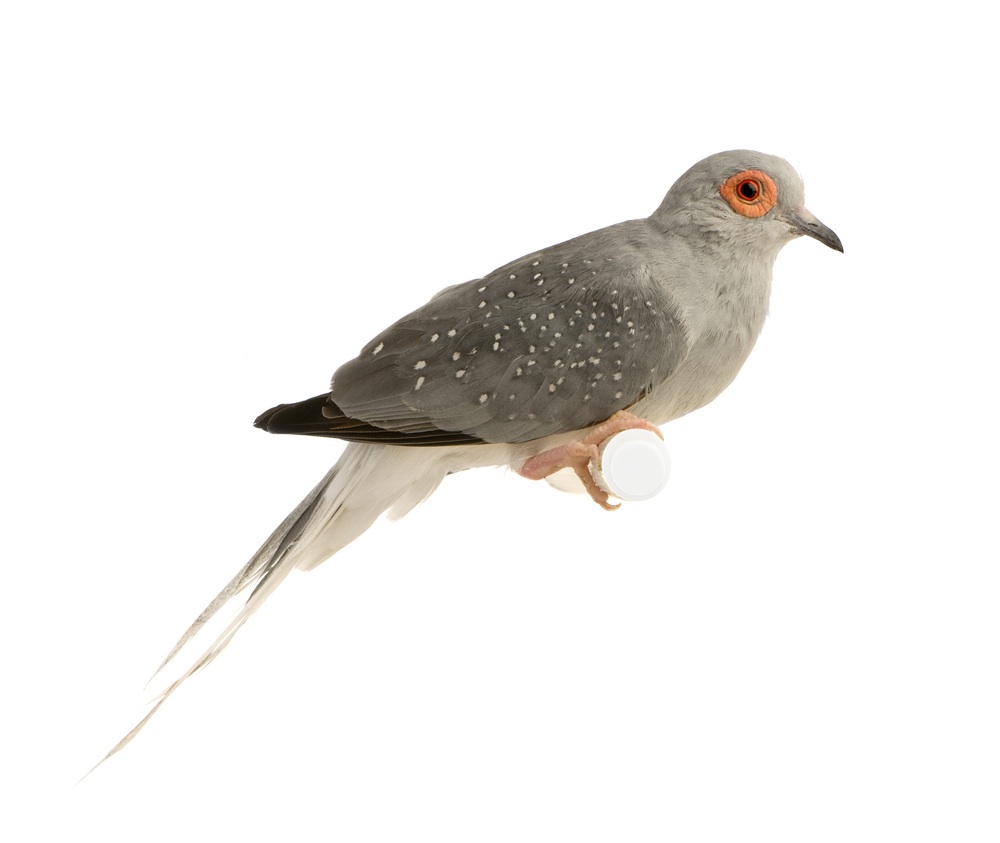Diamond Dove - Geopelia cuneata

 NEWS FLASH:
NEWS FLASH: If you are interested in keeping and breeding pigeons and doves in aviaries, don't miss David Alderton's new ebook, now available from Amazon.com, Amazon.co.uk and Amazon.de, the iBookstore and NOOK.
Origins
Australia, being widely-distributed across the continent.
Length
20cm (8in)
Appearance
Instantly recognisable by its small size, with its long tail feathers accounting for half its body length.
There are white spots on the wings, resembling diamonds in appearance, which are usually less pronounced in hens. When in breeding condition, the red skin around the eyes becomes much more swollen in the case of cock birds. Young birds of both sexes lack this coral-red ring, and are much duller in terms of overall coloration.
Similar species
The Bar-shouldered Dove (G. humeralis) from southern New Guinea, and Australia where it is well-represented in aviculture, although far less well-known in Europe and North America. The orbital skin encircling the eyes is bluish-grey in this case.
Purchasing
Ranks as the most commonly-kept aviary dove, so easily obtainable and relatively inexpensive, although rarer colour varieties are more costly.
Suitability
Most commonly kept in aviaries but youngsters are virtually hand-tame on fledging and can settle very well as household pets. Ideal companions for small finches and non-aggressive softbills.
Care
Ease to look after, being hardy and not destructive to the aviary woodwork. Happily feeds on a range of small seeds, with millets being preferred. Will not eat livefood but can often be persuaded to take softfood when there are chicks in the nest. Chop greenfood such as chickweed when nest sites are in place, because otherwise, this is likely to be used as nesting material and will soon turn mouldy.
Also should be offered budgerigar grit plus cuttlefish bone which provides calcium and helps to prevent the bill from becoming overgrown. Pairs are best kept apart, because they may disagree, especially when nesting.
Breeding
Pairs will attempt to nest through much of the year if given the opportunity. This should be restricted to the spring and summer months in temperate climates however, when the chances of success are highest. Provide a canary nest pan or a slightly larger dove tray with plywood sides as a base for the nest, secured at a reasonably high point in the aviary under cover. The doves will use a variety of materials, including feathers, to line their nest.
Breeding data

Hens lay clutches of 2 eggs. Incubation lasts about 13 days, with this task being shared by both cock and hen. The young will leave the nest after a similar interval.
Colour variants
A growing number, which began with the silver. Others now available include red (a russet shade), blue (with a distinct greyish tone) and cream, plus variants of the body markings, such as the white-rumped.
Health concerns
Repeated losses of young chicks may be traced back to trichomoniasis - an internal microscopic parasitic ailment. The adult birds will be the carriers of the infection, and must be treated, along with any surviving chicks.
Potential lifespan
10-15 years.
Noise rating
Cocks will display readily for much of the year, cooing to their intended mates, but their calls are unlikely to cause offence, either in the home or garden.